The Election is Decided, Just Not Announced Yet
On September 29, over 73 million Americans took to their televisions to witness an unsightly dogfight that some are calling a presidential debate. With two more debates on the calendar leading up to the election, each candidate is looking to sway voters in their direction. Be that as it may, their mission will prove difficult. Here is why.
As a result of the 2016 election, the term “silent majority” has made a comeback. The “silent vote,” which consists of Americans who vote for a candidate but choose not to support them publicly, played a crucial part in the election of President Donald Trump. However, 2020 is a much different story.
President Donald Trump is and has been losing in national polls consistently for the last year. In fact, the deficit has yet to go below 6 percent since June, according to RealClearPolitics. This is nothing new for Trump. He was consistently down in the polls prior to the 2016 election. The difference Trump faces this time around is a greater challenge to overcome.
There is no underestimating Trump in this election. Democrats see him as an urgent matter that must be dealt with. Polarization in the U.S. has plagued Americans, in both a sense of unity and bitterness. People either love Donald Trump or they hate him. There is not much middle ground.
Some promising news for the Trump administration is that a majority of his loyal base seems likely unphased by his recent faux pas.
RealClearPolitics average of national polls show:
- Following accusations of insulting fallen soldiers, the polls remained unchanged.
- Accusations of Trump’s staggering low income tax payments cut Biden’s lead by a point.
- After the first debate, Biden’s lead increased by two points.
- As Trump tested positive for COVID-19, Biden’s lead increased by two points.
Questions surrounding the importance of the popular vote arose following the 2016 election. Due to the electoral vote, Donald Trump was able to defeat former secretary of state Hillary Clinton despite losing the popular vote. In spite of this, current polls paint a much different picture rolling into November.
Florida, Wisconsin and Arizona are just a few of the significant states to watch come Election Day. Each of these state’s electoral colleges voted in favor of the current president last election. If the tides were to turn in these three states as polls are projecting, former Vice President Joe Biden is locked in to win in cosmic fashion.
Voting by mail, while controversial, has been a popular choice amongst American voters this election. Over ten times the amount of votes have already been cast than this time in 2016, surpassing 5.6 million, according to Newsweek. Democrat voters have requested absentee ballots at a much higher rate than Republicans, while conservatives are hoping for a sweeping Election Day voter turnout.
In a Quinnipiac poll, 94 percent already know who they are going to vote for. Donald Trump has had almost four years to convince people that he deserves a second term. He has fans who see him as an underdog, taking on the government establishment and often being politically incorrect. Those opposed see him as lacking the skills to lead the country and an inadequate compassion for marginalized communities, including African-Americans and immigrants. Trump’s main selling point, a strong economy, has been wrecked by the coronavirus. The question for the few undecided may be whether they think Trump can turn that around if given another term.
This election, like most, is a referendum on the incumbent. And when it comes to Donald Trump, everyone has their opinion.












